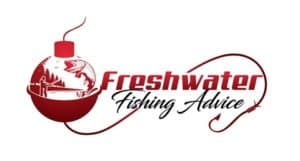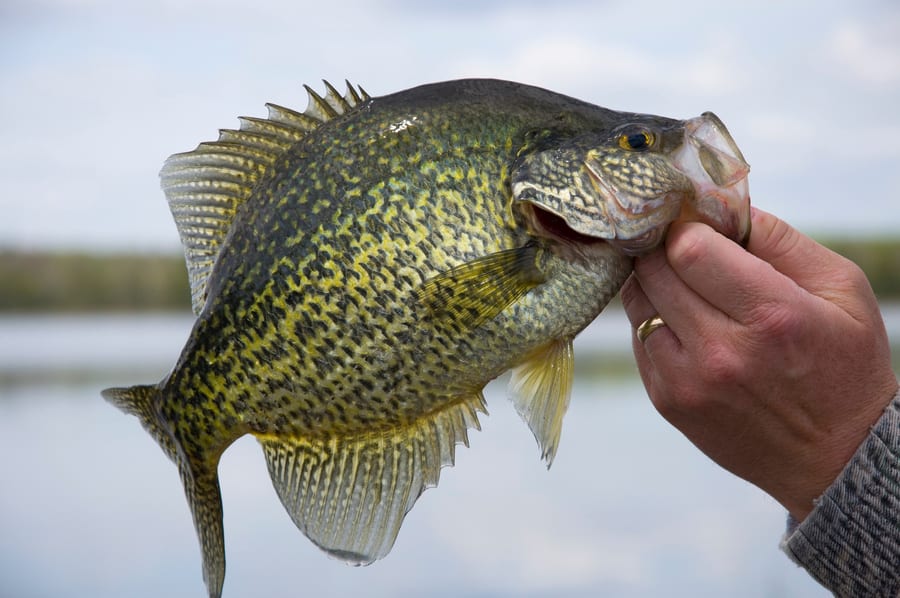


Weather is one of the most crucial factors when setting off to fish for crappie. Handling whatever conditions mother nature dishes out can help you catch more crappie.
Crappie move to deeper water in cold conditions and come to shallower areas near structures when it’s warm. In hot weather, they seek deeper spots during the day but may venture to shallows during dawn and dusk.
| Weather Condition | Impact on Crappie Feeding |
| Sunny and Warm | Focus on schooling baitfish |
| Cold and Clear | Focus on insects and larvae |
| Stormy/Cloudy | Less active, opportunistic feeding |
| Windy | Active near windward sides of structures |
| Increased feeding activity | Reduced feeding activity |
| Falling Pressure | Increased feeding activit |

The best weather for crappie fishing is warm and stable. Barometric pressure should be steady, around 30 inches of mercury. The air temperature is best between 55 and 70 degrees Fahrenheit. Light rain or partly cloudy skies are good. Wind should be slow, coming from the south at 5 to 10 miles per hour.
The worst weather for crappie fishing is cold and changing. Barometric pressure dropping fast is bad. Air temperature below 50 degrees Fahrenheit make crappie inactive. Heavy rain or very clear skies are not good. Strong winds from the north at speeds over 15 miles per hour are bad.
The best time to fish for crappie is early morning and late afternoon. Ideal weather during these times has steady barometric pressure around 30 inches of mercury. Light rain or partly cloudy skies help. Air temperature should be between 55 and 70 degrees Fahrenheit. Winds from the south at 5 to 10 miles per hour are good.
The worst time for crappie fishing is midday when the sun is brightest. Rapidly dropping barometric pressure is bad. Air temperature below 50 degrees Fahrenheit or above 85 degrees is not good. Clear skies and strong winds from the north at over 15 miles per hour make fishing tough.
The best time to fish for crappie at night is after sunset or just before dawn. Stable barometric pressure around 30 inches of mercury is ideal. Light cloud cover or a light mist helps the bite. Air temperature should be between 55 and 70 degrees Fahrenheit. A slow wind from the south at 5 to 10 miles per hour is best.
The worst time to fish at night is during a full moon. Rapid changes in barometric pressure are bad. Avoid air temperatures below 50 degrees Fahrenheit and above 85 degrees. Clear skies with a bright moon make crappie cautious. Strong north winds at over 15 miles per hour are bad for fishing.
In winter, crappie prefer stable barometric pressure around 30 inches of mercury. A new moon is better for fishing than a full moon. Overcast skies make crappie more active. Winds should be slow, coming from the south at 5 to 10 miles per hour.
You’ll find crappie in water temperatures between 35 and 40 degrees Fahrenheit. Early afternoon is the best time to fish in winter. Early morning is the worst time, especially if winds come from the north.
In spring, crappie like stable barometric pressure of around 30 inches of mercury. A new moon or crescent moon is better than a full moon for fishing. Light rain or cloudy skies make crappie more active. Winds from the south at 5 to 10 miles per hour help the bite.
Air and water temperatures between 55 and 70 degrees Fahrenheit are ideal. The best times to fish are early morning and late afternoon. The worst time is midday, especially if the sky is clear and the wind comes from the north.
In summer, crappie like stable barometric pressure around 30 inches of mercury. A crescent moon or new moon is better for fishing than a full moon. Light cloud cover or a light mist helps crappie stay active. Winds from the south at 5 to 10 miles per hour are best.
Water temperatures between 70 and 75 degrees Fahrenheit are good. Early morning and late evening are the best times to fish. Midday is the worst time, especially if the sky is clear and the wind is strong from the north.
In fall, crappie like stable barometric pressure around 30 inches of mercury. A new moon is better for fishing than a full moon. Light rain or cloudy skies are good for crappie activity. Winds from the south at 5 to 10 miles per hour help the bite.
Water temperatures between 55 and 65 degrees Fahrenheit are ideal. Early morning and late afternoon are the best times to fish. Midday is the worst time, especially if the sky is clear and the wind comes from the north.
Crappie move to deeper water when it’s cold. They stay near the bottom in winter. In warm weather, they come to shallower areas near the shore. You can find them around structures like logs, weeds, and rocks in the spring and fall.
When it’s hot, they go to deeper water during the day. Look for them near drop-offs and ledges in the summer. After rain, crappie may move to murky water to hunt for food.
Crappie like stable weather with a barometric pressure of around 30 inches of mercury. In cold weather, they move to deeper water and stay near the bottom. They come to shallower areas near logs, rocks, and weeds when it’s warm. Light rain or cloudy skies make crappie more active.
Winds from the south at 5 to 10 miles per hour are good for fishing. The best times to fish are early morning and late afternoon, while midday is usually the worst. Rapid changes in barometric pressure or strong winds from the north make crappie fishing tough.
| Water Temperature (°F) | Crappie Location | Impact on Crappie Fishing |
| Below 50 | Deep, stable waters | Poor, fewer bites |
| 50-60 | Mid-depths, near cover | Moderate, increasing bites |
| 60-70 | Shallow areas, near cover | Good to Excellent, frequent bites |
| Above 70 | Deep, cooler waters | Moderate to Poor, fewer bites |
| Wind Speed | Crappie Location | Impact on Crappie Fishing |
| Calm | Varied depths | Moderate, consistent bites |
| Light Wind | Leeward side of structures | Good, increased bites |
| Moderate Wind | Windward side near cover | Good to Excellent, frequent bites |
| Strong Wind | Deep, sheltered areas | Poor, fewer bites |
| Cloud Cover | Crappie Location | Impact on Crappie Fishing |
| Clear Sky | Deep water, near cover | Poor, fewer bites |
| Partial Clouds | Varied depths | Moderate, consistent bites |
| Overcast | Shallow areas, near structures | Good to Excellent, increased bites |
| Frontal System | Crappie Location | Impact on Crappie Fishing |
| Warm Front | Shallow, near structures | Good, increased bites |
| Cold Front | Deep, away from structures | Poor, fewer bites |
| Stable Weather | Varied depths | Moderate, consistent activity |
| Post-Front | Transition zones | Improving, gradual increase in bites |
| Precipitation Level | Crappie Location | Impact on Crappie Fishing |
| No Precipitation | Varied depths | Moderate, consistent bites |
| Light Rain | Shallow, near cover | Good, increased bites |
| Heavy Rain | Deep, stable waters | Poor, fewer bites |
| After Rain | Shallow, near cover | Good, increased bites |
| Sunlight Intensity | Crappie Location | Impact on Crappie Fishing |
| Bright Sunlight | Deep water, near cover | Poor, fewer bites |
| Overcast | Shallow areas, near structures | Good, increased bites |
| Dusk/Dawn | Shallow and transition zones | Excellent, high bite rates |
| Nighttime | Varied depths, closer to shorelines | Moderate, consistent activity |
| Moon Phase | Crappie Location | Impact on Crappie Fishing |
| New Moon | Shallow waters at night, deeper during the day | Moderate, consistent bites |
| First Quarter | Varied depths | Moderate, average success |
| Full Moon | Shallow waters at night, transition zones during the day | Good to Excellent, frequent bites |
| Last Quarter | Varied depths | Moderate to Poor, inconsistent bites |
| Season | Crappie Location | Impact on Crappie Fishing |
| Spring | Shallow waters, near structures | Excellent, high bite rates |
| Summer | Deeper waters, near cover | Moderate, fewer bites |
| Fall | Transition zones, shallower waters | Good, consistent bites |
| Winter | Deep, stable waters | Poor, slow fishing |
| Weather Break | Crappie Location | Impact on Crappie Fishing |
| After a Storm | Shallow areas, near cover | Good, increased bites |
| After Cold Front | Deeper, stable waters | Poor to Moderate, fewer bites |
| After Heatwave | Deeper, shaded areas | Moderate, consistent bites |
Crappie usually spawn when the water temperature reaches between 60 and 70 degrees Fahrenheit. They move to shallow waters during this time, often between 1 to 6 feet deep. They like to build their nests near underwater structures like logs, rocks, and plants, and they prefer a sandy or muddy bottom to lay their eggs.
Weather conditions like warm, stable weather can speed up the spawning process, while cold fronts can delay it. Fishing for crappie is generally excellent during the spawn because they are more concentrated in shallow areas and are very aggressive as they defend their nests.
If the weather is warm and stable, focus on the sunniest, shallow areas, where the water will warm quickly, attracting crappies to spawn. If it’s cloudy or a bit cooler, they may be found a bit deeper, but still relatively close to the shore.
Crappie eat different things based on the weather. In warm weather, crappie focus on schooling baitfish like minnows and shad. They chase these small fish in open water. When it’s cold, they eat more insects and larvae because baitfish are harder to find.
Crappie also eat small crustaceans like crayfish, especially in muddy or rocky areas. During storms or cloudy weather, crappie are less active but still eat small fish that come close to their hiding spots. So, their food can change a lot based on the weather and where you find them.
For a complete breakdown of the best water temperature for crapppie fishing, check out this article. For a complete breakdown of the best times for crapppie fishing, check out this article.

